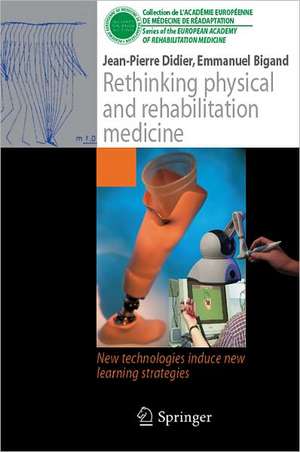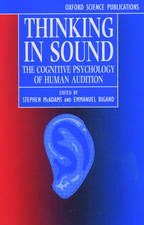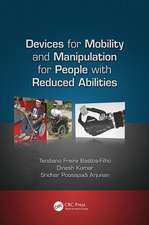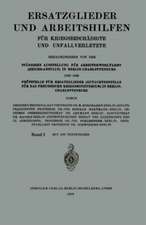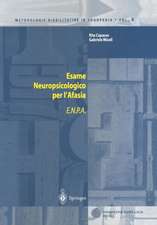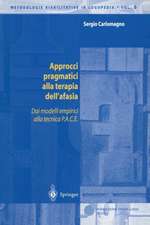Rethinking physical and rehabilitation medicine: New technologies induce new learning strategies: Collection de L'Académie Européenne de Médecine de Réadaptation
Autor Jean-Pierre Didier, Emmanuel Biganden Limba Engleză Paperback – iun 2010
New paradigms of re-education are in fact possible today, thanks to advances in cognitive science, and new technologies such as virtual reality and robotics. They lead to the re-thinking of the procedures of physical medicine, as well as of re-education.
The first part looks anew at re-education in the context of both international classifications of functionality, handicap and health, and the concept of normality. The second part highlights the function of implicit memory in re-education. And the last part shows the integration of new cognition technologies in the new paradigms of re-education.
Preț: 717.20 lei
Preț vechi: 754.95 lei
-5% Nou
Puncte Express: 1076
Preț estimativ în valută:
137.23€ • 143.28$ • 113.58£
137.23€ • 143.28$ • 113.58£
Carte tipărită la comandă
Livrare economică 05-19 aprilie
Preluare comenzi: 021 569.72.76
Specificații
ISBN-13: 9782817800332
ISBN-10: 2817800338
Pagini: 272
Ilustrații: XXII, 246 p.
Greutate: 0.45 kg
Ediția:2010
Editura: Springer
Colecția Springer
Seria Collection de L'Académie Européenne de Médecine de Réadaptation
Locul publicării:Paris, France
ISBN-10: 2817800338
Pagini: 272
Ilustrații: XXII, 246 p.
Greutate: 0.45 kg
Ediția:2010
Editura: Springer
Colecția Springer
Seria Collection de L'Académie Européenne de Médecine de Réadaptation
Locul publicării:Paris, France
Public țintă
Professional/practitionerCuprins
Learning And Education Into Rehabilitation Strategy.- Learning and teaching: two processes to bear in mind when rethinking physical medicine and rehabilitation.- The International Classification of Functioning, Disability and Health (ICF), a unifying model for physical and rehabilitation medicine (PRM).- Rehabilitation and norms.- Implicit Learning: A Basic Learning Process.- A historical perspective on learning: the legacy and actuality of I. M. Pavlov and N. A. Bernstein.- Introducing implicit learning: from the laboratory to the real life.- Implicit learning, development, and education.- Implicit learning and implicit memory in moderate to severe memory disorders.- Learning processes and recovery of higher functions after brain damage.- Learning, Medical Training, and Rehabilitation Practice.- Benefits of learning technologies in medical training, from full-scale simulators to virtual reality and multimedia presentations.- Auditory Training in Deaf Children.- Virtual reality for learning and rehabilitation.- Augmented feedback, virtual reality and robotics for designing new rehabilitation methods.
Textul de pe ultima copertă
“Reeducation” consists in training people injured either by illness or the vagaries of life to achieve the best functionality now possible for them. Strangely, the subject is not taught in the normal educational curricula of the relevant professions. Reeducation thus tends to be developed anew with each patient, without recourse to knowledge of what such training, or assistance in such training, might be. However, new paradigms of reeducation are in fact possible today, thanks to advances in cognitive science and the development of new technologies such as virtual reality and robotics. In turn, they lead to the rethinking of the procedures of physical medicine, as well as of reeducation.
The present book addresses primarily those professionals involved in reeducation: the clinician, kinestherapist, ergotherapist, speech therapist, psychometrician, clinical psychologist, and neuropsychologist. More generally, it addresses also those in occupations in physical rehabilitation and in both primary and ongoing education.
The first part looks anew at reeducation in the context of both international classifications of functionality, handicap, and health and the concept of normality. The second part highlights the function of implicit memory in reeducation. And the last part, illustrated by practical examples, shows the integration of new cognition technologies in the new paradigms of reeducation.
By its combination of theoretical approach and practical application, the work offers new therapeutic routes toward a better and more integrated functionality for the patient.
The present book addresses primarily those professionals involved in reeducation: the clinician, kinestherapist, ergotherapist, speech therapist, psychometrician, clinical psychologist, and neuropsychologist. More generally, it addresses also those in occupations in physical rehabilitation and in both primary and ongoing education.
The first part looks anew at reeducation in the context of both international classifications of functionality, handicap, and health and the concept of normality. The second part highlights the function of implicit memory in reeducation. And the last part, illustrated by practical examples, shows the integration of new cognition technologies in the new paradigms of reeducation.
By its combination of theoretical approach and practical application, the work offers new therapeutic routes toward a better and more integrated functionality for the patient.
Caracteristici
In rehabilitation caregivers and patients are united in a mutual learning process. The practitioner is a teacher who should know learning mechanisms and methods allowing the patient to learn. The patient must allow the therapist to implement an education adapted to its environment and life project. The aim is to obtain a better social integration and better functioning under the ICFDH. The book provides theoretical and practical applications to describe this new therapeutic management.
